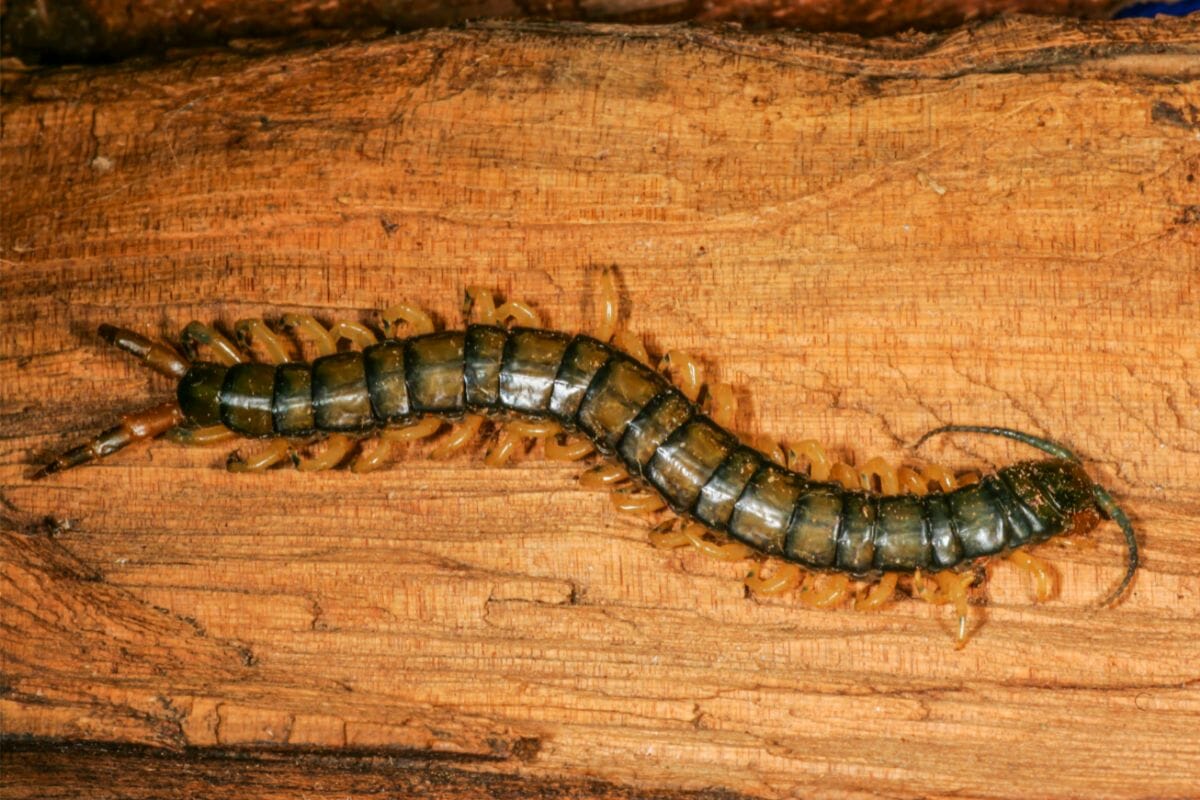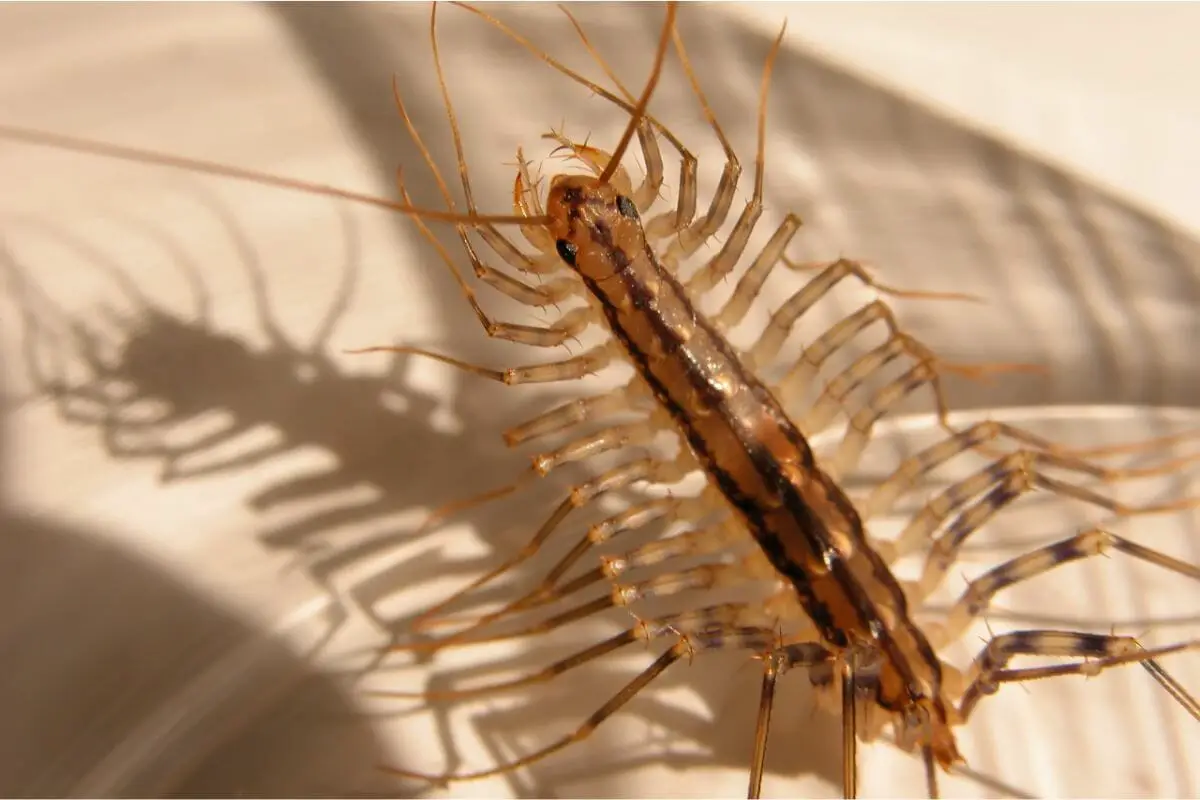Centipedes are actually very recognisable for their long, flattened and flexible bodies with a lot of legs to navigate them around.

While centipede actually stands for ‘100 legs’ in Latin, in actuality depending on the kind of centipede they can range from as few as 15 pairs of legs to 191.
Surprisingly, despite their smaller stature, centipedes are also known for being carnivorous hunters and can consume small birds and even frogs with the help of the venomous fangs buried within their first set of legs, and their large poisonous claws at the mouthpiece.
While mostly all centipedes share similar characteristics in terms of how they eat and their general biological structure, depending on the type of centipedes they can actually vary in look and function quite widely, so to make this clearer we have taken a deep dive into some of the most common and interesting kinds of centipedes you can find and what makes them stand out.
Cryptopid Centipedes
Cryptopid Centipedes are one of the most common centipede variants which you have probably seen before at least once.
They are very recognisable by their reddish-brown scaly appearance.
They are more suited to outdoor environments and can usually be found under large logs and stones, but they can also be known to wander into more humid areas of the house such as basements, cellars and laundromats.
One of the most distinguishable parts of a Cryptopid Centipede, and why many people find them one of the most annoying and troublesome variants to get rid of, is how fast and silent they are along with having an armored plate covering their entire 3 inch long body to help them bend as they move, and give them a lot of protection from being killed.
Bark Centipedes
In contrast, bark centipedes almost exclusively live outdoors on rocks, logs, leaves and any debris piles.
Because their body is fairly large for an insect, bark centipedes will eat insects and other small arthropods which are their size or a bit smaller.
To catch their prey, bark centipedes pinch in place and bite a creature with their last pair of legs.
They then inject venom into their prey which comes from their fangs near the mouthpiece.

While these bites are not fatal to humans, they can still cause swelling and remain quite painful for several hours.
Because they are known to eat animals including spiders and cockroaches, some even say that bark centipedes are handy to keep around the house to clear up any nasty insects or creatures you have living around the house which you may want to get rid of, but don’t want to get too hands on doing it.
House Centipedes
While the name may suggest that these centipedes are commonly seen all over the house, in fact house centipedes have an incredibly peculiar appearance which you could swear is a different creature altogether.
The legs of a house centipede are so close together that they almost look like feathers.
They have fifteen pairs of legs all together which are extremely long and extend around their entire body with the much smaller body lying in the middle.
They have a black and yellow appearance with a dark line running down their ‘spine’.
They are extremely fast, being able travel from 0-60 mph in just a few seconds, and while they are not considered to be aggressive towards humans, they use this speed to sneak up on and catch their prey which are pests including cockroaches and moths.
This also makes them a type of centipede that some people actually don’t mind having around the house so they can quickly rid (see also: How To Get Rid Of Bandicoot Around House (Easy Solution))any pests that might be hiding in hard to reach areas, however it does mean you will have to look past their strange and peculiar appearance.
Soil Centipede
As the name suggests, while most other types of centipedes will roam around humid areas both inside the house and in the garden, soil centipedes live in the soil and are actually very important in the underground ecosystem.
They are long and flexible being quite similar to a worm which helps their body bend and curl to easier navigate through the soil.
They will often hide through the day and usually roam around the soil looking for food at night.
They are most often revealed when moving an overhead shelter where they can be found rushing back to the soil to get away from the light exposure.

Because of the way soil centipedes work, they will travel through the soil and aerate it as they go which helps improve the liveliness and quality of the soil making it much easier for plants to grow and making for a better ecosystem overall.
Giant Red-Headed Centipede
One of the longest and most colorful variants of centipedes, these are actually a type of bark centipede but have a slightly more flexible body which allows them to fit into extremely tight spaces.
They are known for having a combination of colors covering their body, usually being a mixture of red, black and yellow which can cover their head, body and legs.
They have a very distinct appearance having two fleshy long tails at their rear end which can be mistaken for a head.
On their actual head, they all have an antennae and a strong mouthpiece that helps bite skin and injects venom that can cause burning and swelling in other creatures.
These types of centipedes are usually more active on cloudier days and like to remain in cooler environments and can be found under rocks and debris on warm and sunnier days.
Summary
While all centipedes can be easily identified by their many pairs of legs and long flexible body, in terms of speed, appearance and even where they prefer to reside, centipedes can actually differ quite a bit.
While all are equipped with venomous legs and fangs, luckily they are never likely to attack humans and will only reserve this for creatures their own size.
- What Should I Do If A Koala Bites Me? Safety Guide - 2024-05-30
- Are Kangaroos Born Without Hind Legs? A Fascinating Journey - 2024-05-30
- Animals That Look Like Squirrels - 2024-05-30









